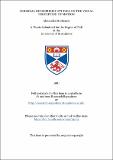Files in this item
Cerebral hemispheric studies on the visual perception of motion
Item metadata
| dc.contributor.advisor | Milner, David | |
| dc.contributor.advisor | Rogers, Brian | |
| dc.contributor.author | Mackenzie, Alexander | |
| dc.coverage.spatial | 402 p. | en_US |
| dc.date.accessioned | 2018-06-26T08:29:35Z | |
| dc.date.available | 2018-06-26T08:29:35Z | |
| dc.date.issued | 1981 | |
| dc.identifier.uri | https://hdl.handle.net/10023/14574 | |
| dc.description.abstract | Experiments were conducted to examine the differential capabilities of the cerebral hemispheres for the visual perception of motion. Subjects were normal right handed adult male and female humans. Stimuli were viewed binocularly and responses were manual in all studies. Lateralized low contrast real motion was presented using random texture patterns. The task was to correctly detect the direction of motion. The outcome was a significant hemisphere x trials interaction. The right hemisphere improved significantly over trials while the left hemisphere did not. Using random texture patterns in which a small lateralized square was presented in apparent motion, hemispheric superiorities were found to depend on fairly basic stimulus parameters. For low contrast relatively long stimulus field durations, the right hemisphere was significantly superior. For higher contrast apparent motion stimuli with a "masking" ISI, the left hemisphere was significantly better at accurately detecting the direction of motion. V shaped stimuli may be presented in apparent motion so as to be seen as either moving within the stimulus plane, or rotating in depth outside it. The percentage of "space" (i.e., rotation) responses increases as the ISI is lengthened. The hemispheres did not differ significantly in their judgments of motion in depth, therefore, they appear to be employing identically calibrated detection mechanisms. However, female right hemisphere "space" responses remained constant over trials, while analogous male responses decreased linearly. Stimulus parameters which had been shown in earlier experiments to result in hemispheric differences were avoided, and subjects required to identify apparently moving shapes in a random texture background. No hemispheric differences were observed in this detection task. An additional finding was that female subjects tend to more frequently report that sub-vocal verbalization mediated their (manual) responses. | en_US |
| dc.language.iso | en | en_US |
| dc.publisher | University of St Andrews | |
| dc.subject.lcc | QP493.M2 | |
| dc.subject.lcsh | Movement | en |
| dc.title | Cerebral hemispheric studies on the visual perception of motion | en_US |
| dc.type | Thesis | en_US |
| dc.type.qualificationlevel | Doctoral | en_US |
| dc.type.qualificationname | PhD Doctor of Philosophy | en_US |
| dc.publisher.institution | The University of St Andrews | en_US |
This item appears in the following Collection(s)
Items in the St Andrews Research Repository are protected by copyright, with all rights reserved, unless otherwise indicated.

